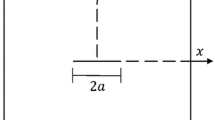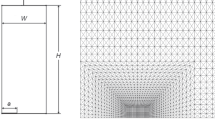Abstract
A method for the determination of the stress intensity factors of a cracked body using a conic-section-simulation model of the crack surface is presented. Stress distribution around the crack is determined using a finite element code having the elastic crack tip singularity 1/√r. This method improves the accuracy of the stress intensity factor values and is simple enough to be used with most standard isoparametric finite element programs. The method also eliminates the necessity of extrapolation to estimate the stress intensity factors at the crack tip.
Résumé
On présente une méthode pour déterminer les facteurs d'intensité de contrainte d'un corps fissuré en utilisant un modèle de simulation à section conique de la surface de la fissure. La distribution des contraintes aux alentours de la fissure est déterminée en utilisant un code d'eléments finis possédant un singularité de l'extrémité élastique de la fissure 1/√r. Cette méthode améliore la précision des valeurs de facteur d'intensité de contrainte et est suffisamment simple pour être utilisée dans la plupart des programmes d'élément fini standard isoparamétrique. La méthode élimine également la nécessité d'extrapoler à des valeurs estimées des facteurs d'intensité de contrainte aux extrémités de la fissure.
Similar content being viewed by others
References
P.C. Paris and G.C. Sih,Fracture Toughness Testing and Its Applications, STP 381, ASTM Philadelphia, Pa. (1965) 30–76.
N.I. Muskhelishvili,Some Basic Problems of the Mathematical Theory of Elasticity, Noordhoff, Holland (1953).
A.S. Kobayashi, R.D. Cherepy and W.C. Kinsel,Journal of Basic Engineering 86 (1964) 681–684.
J.E. Srawley and B. Gross, Materials Research and Standards 7 (1967) 155–162.
O.L. Bowie and D.M. Neal,International Journal of Fracture 6 (1970) 199–206.
J.C. Newman, Jr., NASA TND-6376 (1971).
C.L. Chow and K.J. Lau,Journal of Strain Analysis 11 (1976) 18–25.
O.C. Zienkiewicz,The Finite Element Method in Engineering Science, McGraw-Hill, New York (1971).
S.K. Chan, I.S. Tuba and W.K Wilson,Engineering Fracture Mechanics 2 (1970) 1–17.
J.L. Swedlow, M.L. Williams and W.H. Yang,Proceedings of the First International Conference on Fracture 1 (1966) 259–282.
A.S. Kobayashi, D.E. Maiden, B.J. Simon and S. Isida, ASME paper No. 69-WAJPVP-12 (1969).
J.R. Dixon and J.S. Strannigan,Journal of Strain Analysis 7 (1972) 125–131.
D.J. Hayes,International Journal of Fracture 8 (1972) 157–165.
V.B. Watwood, Jr.,Nuclear Engineering Design 11 (1969) 323–332.
E. Byskov,Engineering Fracture Mechanics 6 (1970) 159–167.
D.M. Tracey,Engineering Fracture Mechanics 3 (1971) 255–265.
J.R. Rice and D.M. Tracey, Numerical and Computer Methods in Structural Mechanics, Academic Press (1973) 585–621.
T.H.H. Pian, P. Tong and C.H. Luk,Proceedings Air Force 3rd Conference on Matrix Methods in Structural Mechanics, AFFDL-TR-71-160, Wright-Patterson A.F.B. (1971).
S.E. Benzley,International Journal of Numerical Methods in Engineering 8 (1974) 537–545.
R.S. Barsoum,International Journal of Fracture 10 (1974) RCR 603–605.
R.S. Barsoum,International Journal of Numerical Methods in Engineering 10 (1976) 25–37.
R.D. Henshell and K.G. Shaw,International Journal of Numerical Methods in Engineering 9 (1975) 495–507.
C.L. Chow and K.J. Lau,International Journal of Fracture 12 (1976) 59–69.
C.L. Chow and K.J. Lau,International Journal of Fracture 12 (1976) 669–684.
I.N. Sneddon and M. Lowengrub, Crack Problems in the Classical Theory of Elasticity, John Wiley and Sons, Inc., New York (1970).
M. Isida,International Journal of Fracture 7 (1971) 301–316.
W.F. Brown and J.E. Srawley,Plane Strain Crack Toughness Testing of High Strength Metallic Materials, STP 410, ASTM (1967).
K.J. Lau, Ph.D. Thesis, University of Hong Kong (1975).
G.C. Sih, P.C. Paris and F. Erdogan,Journal of Applied Mechanics 29 (1962) 306–317.
W.K. Wilson, Research Report 69-IE7-FMECH-RI, Westinghouse Research Laboratories, Pittsburgh (1969).
H.D. Hibbit,International Journal of Numerical Methods in Engineering 11 (1977) 180–184.
J.R. Rice,Journal of Applied Mechanics 35 (1968) 379–386.
Author information
Authors and Affiliations
Rights and permissions
About this article
Cite this article
Woo, C.W., Kuruppu, M.D. Use of finite element method for determining stress intensity factors with a conic-section simulation model of crack surface. Int J Fract 20, 163–178 (1982). https://doi.org/10.1007/BF01140333
Received:
Revised:
Issue Date:
DOI: https://doi.org/10.1007/BF01140333




